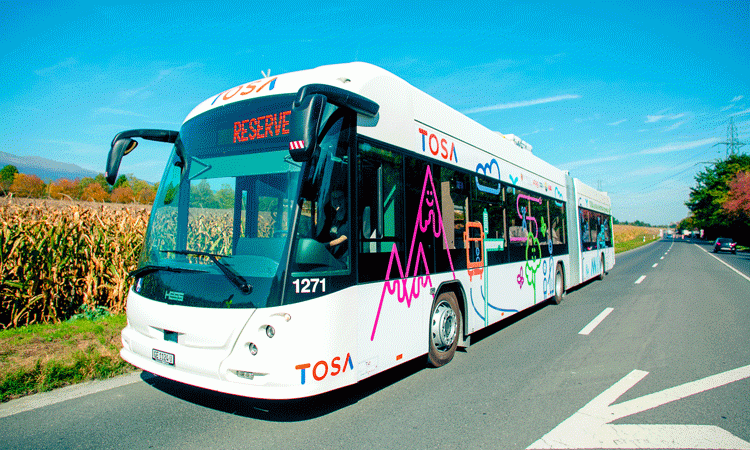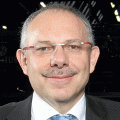TOSA: Geneva’s electrical bus innovation
- Like
- Digg
- Del
- Tumblr
- VKontakte
- Buffer
- Love This
- Odnoklassniki
- Meneame
- Blogger
- Amazon
- Yahoo Mail
- Gmail
- AOL
- Newsvine
- HackerNews
- Evernote
- MySpace
- Mail.ru
- Viadeo
- Line
- Comments
- Yummly
- SMS
- Viber
- Telegram
- Subscribe
- Skype
- Facebook Messenger
- Kakao
- LiveJournal
- Yammer
- Edgar
- Fintel
- Mix
- Instapaper
- Copy Link
Posted: 11 October 2017 | Thierry Wagenknecht (TPG) | No comments yet
Thierry Wagenknecht, Technical Director, Transports publics genevois (TPG), explains the advantages of Trolleybus Optimisation Système Alimentation (TOSA) technology over the more traditional overhead lines of the trolleybus system.


In 2016, ABB was contracted by TPG and Swiss bus manufacturer HESS to provide flash charging and on-board electric vehicle technology for 12 TOSA e-buses for Line 23, connecting Geneva airport with the suburbs.
This route is expected to carry 10,000 passengers a day and reduce carbon emissions by up to 1,000 tonnes per year. The project is supported by the State of Geneva and the Swiss Federal Office of Energy (SFOE) as part of a flagship program.
TOSA technology gives electric buses the same flexibility as diesel buses while remaining 100 per cent ecological. Based on ultrafast charging technology, which transfers energy between the vehicle and the charging stations via an articulated arm, the TOSA bus quickly recharges, at the stop (20 seconds) and at the terminus (four minutes).
An innovation on the roof
The main technological innovation lies in the energy transfer system installed on the bus roof. It is an automatic articulated arm that rises when the bus approaches an equipped stop and connects in just one second to a recharging rail when the vehicle stops. This is called ultrafast charging.
This connection makes it possible to transfer (in barely 20 seconds, during the descent and ascent of the passengers) a sufficient amount of energy – making it possible to store up the equivalent of four minutes of recharge time at the terminals. By way of comparison, this transferred energy would make it possible to recharge 10 electric bicycles in 20 seconds!
TOSA buses do not need to be constantly connected to electrical cables that clutter the landscape.
In addition, compared to trolleybuses, due to the absence of overhead lines, the great advantage of TOSA technology is that it allows a considerable reduction in the size of the on-board batteries. Result: a gain in capacity (15 per cent to 30 per cent more in places) and in energy consumption (about 10 per cent saving) since the vehicle is lighter.
A clean and better consumed energy
The effective use of electrical energy is the essence of TOSA. The whole design of the bus has been considered in this spirit, and the innovations that result from it aren’t limited to just ultrafast charging. For example, the TOSA bus recovers energy during braking, deceleration and descent. This energy is directly stored and consumed inside the vehicle. With the batteries on the roof of the vehicle, the generated electricity is used for the start-up and rolling phases instead of being returned to the overhead lines as is the case with trolleybus lines.
TOSA represents a major innovation in energy and network management, with the integration of energy storage and high-power transfer dimensions (smart-grid and smart-metering). Computer technologies are used to optimise the production and distribution of electricity according to consumption (in quantity and location). In this way, the losses of electricity that happen on airlines are avoided.
In addition, the project allows the development of renewable energies in the public transport sector. Indeed, the Geneva Industrial Services company (SIG), which supply electricity to the Geneva Public Transport (TPG), only distribute electricity of 100 per cent renewable origin of hydraulic origin (of which more than 23 per cent are produced locally) for trams, trolleybuses and future TOSA buses.
The infrastructure
In addition to the energy transfer system installed on the bus roof, TOSA technology is also made up of recharging stations located at certain stops along the route which allow the transfer of energy between the electrical network and the batteries of the vehicles.
There are three types of charging stations:
- Flash Stations (Flash Feeding Station – FFS)
- Terminal Feeding Station (TFS)
- Depot Feeding Station (DFS)
The function of the Flash Stations is to partially recharge the on-board batteries of the buses during the time of passenger transfer at the stops, i.e. 20 seconds. They are equipped with a storage module, helping to smooth the peaks of electrical consumption.
These are Lithium-ion (LIB) batteries. This choice is justified by a much lower volume and cost of batteries. The batteries have a storage capacity of 88kWh, which is oversized in order to provide full power, as well as having a tank needed to manage one bus train (one bus follows the other).
This cycle of charging/discharging makes it possible to estimate a lifetime of 10 years for the module LIB of the stations of recharge flash. For optimum battery operation, it is necessary to maintain a temperature of less than 55°C in the heart of the energy storage module. Water cooling has therefore been studied in order to maximise the life of the batteries.
The terminal stations are responsible for completely charging the vehicle batteries during a vehicle’s hourly delivery at the terminus (four to five minutes). Because of the high utilisation rate (very small time intervals between each recharge), these stations are not equipped with an energy storage module (such as batteries, supercapacitors, etc.) which would reduce the power of connection. This is 436kVA, providing an output power of about 400kW.
The articulated TOSA bus
The 100 per cent electric TOSA buses are high-capacity buses, currently developed in an articulated version of 18m to accommodate nearly 110 passengers. These buses offer the same level of comfort as a diesel or a trolley bus, without compromise on air conditioning or heating. In addition, TOSA vehicles on Line 23 will be equipped with USB ports on face-to-face seats at the front of the vehicle, allowing recharging of personal mobile equipment. Everyone will be able to recharge their own batteries in the TOSA buses!
The TOSA bus batteries are located on the roof of the vehicle, which ensures a flat and low floor over the entire length of the bus. They will have an electrical storage capacity of about 73kWh for a weight of only one tonne. By way of comparison, the capacity of Tesla S cars varies, depending on the model, from 60-100kWh. TOSA buses do not require high power batteries since autonomy is not a major factor. Indeed, due to the technique of ultrafast charging which allows partial recharge of the bus’s batteries during their journey, the TOSA buses need to carry far fewer batteries than an electric bus that would be charged at night only: it would take five to seven tonnes more!
Thus, TOSA buses carry more passengers and fewer batteries than conventional electric buses, which is obviously positive for the environment, since this means fewer batteries to be recycled.
A charging pole completes the infrastructure of the flash and terminal stations. Raising to more than 7m, it supports a rail in which the articulated automatic arm of the vehicles is connected. This rail, located at a height of 4.5m above the road, allows the transfer of energy between the electric cabinets and the batteries of the buses. When no arms are connected to the rail, there is no electrical current in the stem and rail for total safety. By contact, the energy transfer generates no electromagnetic field, unlike other energy transfer technologies, such as induction.
More innovation to manage critical assets
Today, with this fast development of electric buses, the question arises of the industrialisation and the monitoring of these solutions as a whole.
Asset management becomes an important target in digitalisation of bus fleet maintenance solutions.
The electric buses currently have a longer service life than the diesel buses. The major components, like batteries, of the acquisition cost and requiring one or more renewals, charging stations, energy efficiency management and monitoring of real-time operations, push operators to implement integrated solutions.
In Geneva at the end of 2017, the commissioning of the 12 TOSA electric buses with more than 15 charging stations at stops and terminals, as well as night charging facilities at the maintenance centre, will be an asset management pilot with the integration of data feedback, energy efficiency, operational safety, maintenance and asset management.
ABB announced in September that Transports publics genevois (TPG), Geneva’s public transport operator in Switzerland, has placed an order for an ABB Ability based solution comprising a supervisory control and data acquisition (SCADA) system and enterprise asset management (EAM) software. The solution will help optimise the TOSA fully electric buses (e-buses).
The ABB Ability Network Manager SCADA system will be used to monitor and control the power network for the charging stations and e-buses, maximising availability and operational efficiency. It will be integrated with the ABB Ability Ellipse Select, EAM software with embedded best-practice parameters and industry specific workflows. This will further optimise maintenance processes, enable a fast response to fault incidents and better predict maintenance needs. The overall solution is also equipped with remote access and ‘cloud’ capabilities and is scalable to meet future needs.


Related topics
Alternative Power, Fleet Management & Maintenance
Issue
Issue 1 2017
Related modes
Electric bus
Related cities
Europe








